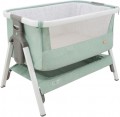Material
The material from which the crib is made affects both the usability and the features of it.
—
Wood. The most common material today: wood is relatively cheap, looks good and has a nice touch, so it does not need to be covered with other materials (like metal cribs, which are usually covered with fabric). It has average characteristics in terms of strength, weight and cost, which allows it to be used in both cribs and cradles (refer to "Type").
—
Plastic. The main advantage of plastic is its low weight and cost, due to which it is used mainly in cradles. However, its strength is usually lower than that of wood.
—
Metal. The main advantage of metal is its high strength. On the other hand, it is unpleasant to the touch (cold), and it does not look very suitable for cribs. Therefore, only a frame is usually made of metal, on which walls and the base made of fabric and/or mesh are stretched.
— Wood/plastic. An option found mainly in themed teenage beds (see "Type"). In such models, the crib is made of wood, which provides it with the necessary strength, and for the decorative finish are used parts of inexpensive and easy to produce plastic (which in addition can be given almost any color).
Regardless of the material, when buying, you should pay attention to the compliance of the crib with sanitary and hygienic standards.
Sidewalls
The type of sidewalls of the crib.
—
Slatted. They consist of vertical slats, for more details on the advantages and disadvantages of this design, refer to "Endwalls".
—
Solid. A solid surface with no recesses or holes. For more information on the advantages and disadvantages of this design, refer to "Endwalls".
—
Mesh. This wall is a frame with a mesh installed in it. It provides slightly better protection against drafts than a slatted wall; on the other hand, it is poorly suited as a support for the baby. It is used rather rarely, usually when it is difficult to install slats.
— Slatted/solid. This means that one sidewall is solid and the other is slatted. Such a crib is usually placed with a solid sidewall against the wall. Thus, parents can see the baby through the front wall, the baby can use the slats as a support for standing up, and the solid back wall protects it from drafts and contact with the wall.
— Solid/mesh. Solid walls, usually made of dense fabric, supplemented with mesh inserts. These inserts are designed to improve ventilation and to allow parents to see the baby better.
Drawer / laundry basket
The presence of a drawer or basket near the bed (usually located under the bottom). Most often, such elements are used to store bed linen, but clothes, toys, etc. can also be stored there. (although if you want to store a lot of things next to the bed, you should pay attention to models with a chest of drawers). Sometimes there can be several
drawers for linen.
Lockable wheels
The latches are designed to
block the rotation of the wheels of the bed and prevent it from moving — for example, if a nearby baby tries to climb onto the bed or grab to stand up, the bed without latches can move, which is fraught with unpleasant consequences.
Mattress
The size of the mattress in length and width in centimeters. The standard sizes of baby mattresses are 60x120, 70x120 and 70x140; you should pay attention to these sizes if you plan to buy a mattress separately from the crib.
The length of baby cribs varies from 90 to 140 cm, with 120 cm being the most common. The smaller size means that the crib will have to be changed sooner, and the longer lengths are usually convertible cribs (refer to "Type") designed not only for babies, but also for preschoolers and schoolchildren.
The width of the mattress can vary from 40 to
70 cm, and the most common option is
60 cm, this is considered quite enough. As in the case of length, a smaller width means that the baby will become cramped in it earlier, and usually convertible models have a larger width.
All of the above does not apply to cradles (refer to "Type") — they are designed only for the smallest and are much smaller.
Country of origin
The country of origin of the brand under which the product is presented on the market. Often indicated by the nationality of the company or the location of its headquarters. However, the actual production capacity of the brand often differs from the country of origin.
It should be noted that the quality of products depends not so much on geography as on the organization of processes and quality control at all stages of production. Therefore, national prejudices about brands from certain regions are usually not supported by anything. It is only necessary to pay attention to the country of origin of a brand if the goal is to support or avoid a manufacturer from a particular country.

